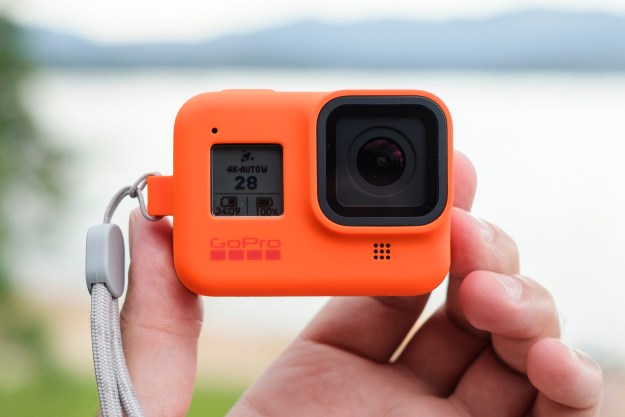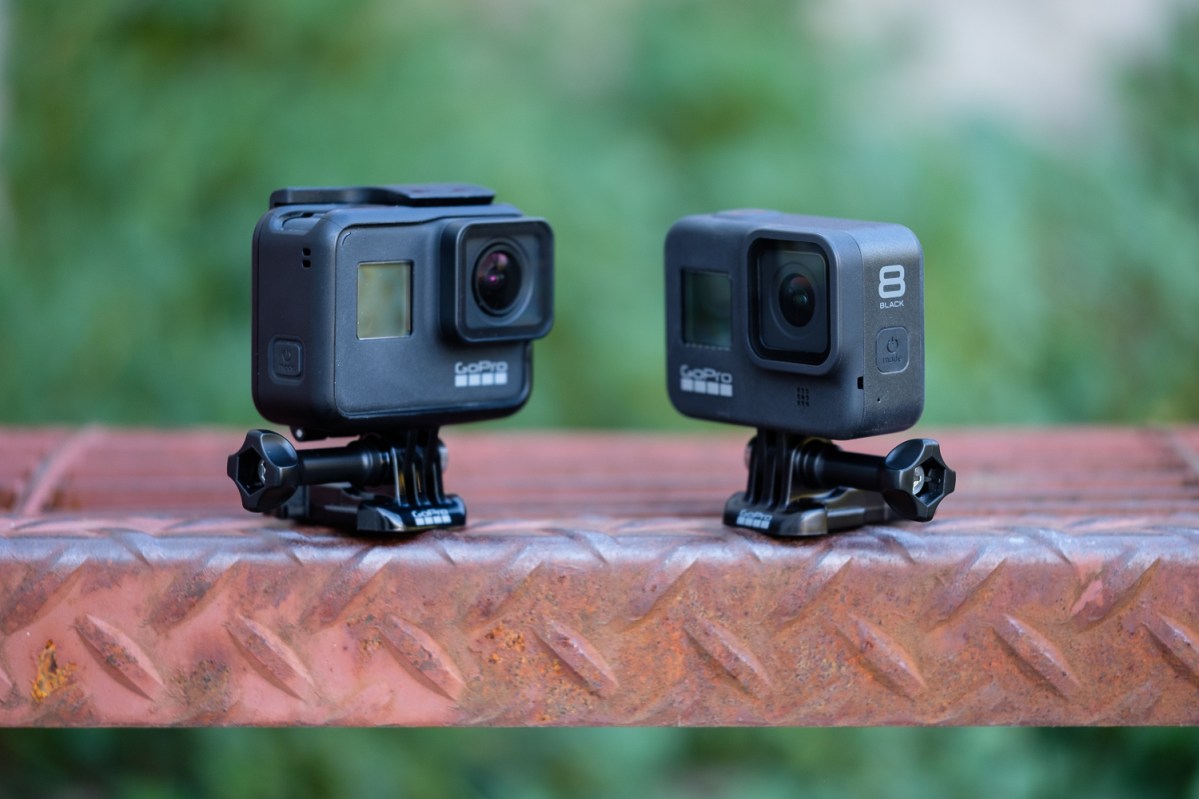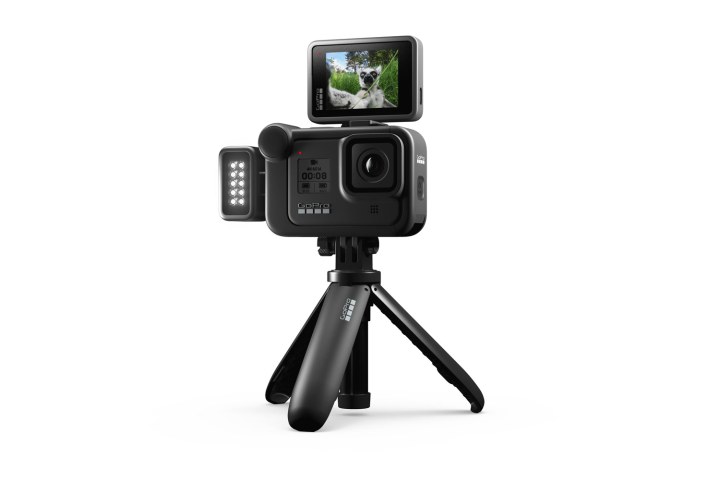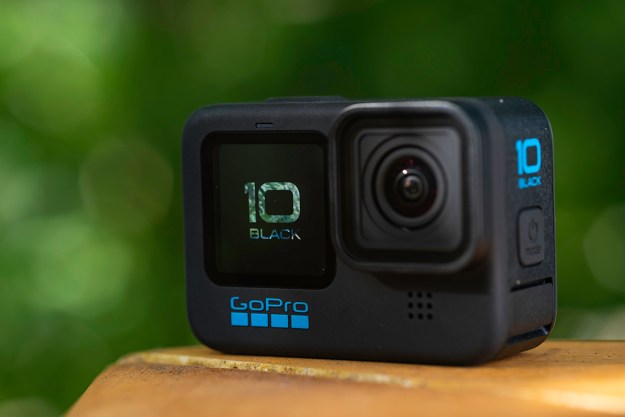
- Integrated mount
- Ridiculously good stabilization
- Automatic horizon leveling
- Side access to battery and card
- New "mod" support
- Small, 4:3 LCD screen
Last year’s Hero7 Black was GoPro’s biggest release in years. It introduced HyperSmooth, a type of electronic image stabilization (EIS) so good you didn’t need a gimbal — even for the roughest trail runs or rides. It was a truly useful innovation that set a new bar for EIS, and action cameras in general.
It also raised an important question: Where could GoPro possibly go from there?
The answer is the $400 Hero8 Black, which features the first physical redesign since 2016’s Hero5 Black and includes an integrated mount — that’s right, you can ditch the mounting frame. It’s also compatible with a new line of accessories, called Mods, which transform the camera into a powerful vlogging and storytelling tool.
Then there’s HyperSmooth 2.0, which now works across all frame rates and resolutions. Combined with optional horizon leveling, it’s another leap forward for EIS.
It’s only been a year, but with these and many other new features, the Hero8 Black compares very favorably against the Hero7 Black. More importantly, GoPro’s latest flagship proves the company that started the action cam craze still has what it takes to compete — and win — against the likes of DJI, Yi, and the myriad other competitors that have sprung up in its wake.
New design and user interface
The new design looks largely the same, but it hides a key functional improvement. On the bottom of the camera, recessed and hidden from view, are two tabs that fold out to form the traditional GoPro mounting hardware. You previously had to place the camera into a case or frame before using it with a mount.
While this has caused the size of the product to swell ever so slightly compared to a naked Hero7, it is actually smaller than a Hero7 wearing a frame. And since a GoPro is almost always mounted to something — be that a helmet or a selfie stick — the Hero8 does offer a small size advantage compared to previous models.

This also adds the convenience of accessing the memory card and battery without having to first remove a frame. And thanks to the new side door, you don’t even have to remove the camera from whatever it’s attached to swap the battery or card. These small improvements go a long way toward improving the user experience.
The lens is unchanged but now sits behind a protective glass that is thicker and twice as hard as before. Despite this, it also protrudes less from the body, making the camera slimmer overall. As a consequence, the glass can no longer be removed or replaced, so a separate frame will be required if you want to use filters.
The touch interface has also been tweaked so it’s easier to navigate, with a new presets menu that allows you to quickly bring up different modes for different situations. In addition to the default modes, you can save up to 10 of your own custom presets for different activities or styles of shooting and label them accordingly. Four customizable on-screen buttons also give you quick access to settings like stabilization, zoom, exposure compensation, white balance, and more.
GoPro already had the best-in-class touch interface, and I’m pleasantly surprised to see that the Hero8 has made it even better. You’ll still hit the wrong button occasionally due to the limited screen real estate, but using this camera is otherwise a breeze.

What I’m not so happy about is the LCD screen itself. It’s the same basic unit that’s been around since the Hero5, and it is definitely starting to show its age. It’s too small and the wrong aspect ratio for video. The one thing the DJI Osmo Action introduced that was inarguably superior to GoPro was its large 16:9 screen, and I would have expected GoPro to compete with that on the Hero8. (I don’t mind at all that GoPro didn’t copy DJI’s front-facing screen, as it came up with an alternate solution that I’ll get to below.)
Nevertheless, the Hero8 Black sets a new benchmark for action camera design, one that will likely hold up well into the future.
HyperSmooth 2.0 and TimeWarp 2.0
Just like HyperSmooth was the reason to buy a GoPro Hero7 Black, HyperSmooth 2.0 is what will make you covet the Hero8 Black. It offers improved stabilization performance without changing the amount of crop (which is 10%). If you don’t mind a more significant crop, you can turn the stabilization up even higher with the new Boost mode, something GoPro said would be great for follow-cam filming.
Not that I found a need for it. Whatever I threw at the Hero8, from a mountain roller-coaster to a trail run, standard HyperSmooth 2.0 handled it with ease. Never before has it been this easy to get professional-quality results with so little effort. In short, your videos will finally look more like GoPro’s official promo videos.
Horizon leveling also helps take stabilization to the next level. This is a feature borrowed from the GoPro Fusion 360 camera, but it’s rare to see it on a non-360 camera. It’s not on by default, but you can activate it within the GoPro mobile app. Of course, unlike a 360 camera, the Hero8 has a limited field of view to work with, so extreme horizon leveling will result in a noticeable crop to the footage. In practice, this was never a problem for me, and using horizon leveling often resulted in a more polished shot. It’s a lifesaver for those times when mounting or holding the camera perfectly level just isn’t possible.
But my personal favorite new feature is something less about practicality and more about fun: TimeWarp 2.0. Like the TimeWarp mode introduced on the Hero7 Black, it creates a stabilized motion time-lapse video — or hyperlapse — that looks almost impossibly slick when played back.
Version 2.0 adds a couple of neat tricks. First, it automatically calculates the time-lapse speed based on the amount of camera motion. Second, you can slow down to real time with the tap of an on-screen button, and then speed back up into hyperlapse with a second tap. Although it sounds basic, this is a feature that is sorely missing from most hyperlapse modes and apps. It allows you to draw attention to important objects or moments, or build up to the dramatic conclusion of your journey. It’s also just a lot of fun to play with.
Another new feature is LiveBurst, which buffers frames before the shutter button is pressed, then saves 1.5 seconds of footage captured before and after pressing it. Like Apple’s Live Photos, you can then select a single frame or save the entire 3-second clip as a video. I personally didn’t find this to be all that useful, but some people will appreciate the option.
For standard photos, GoPro has re-tuned its SuperPhoto mode for better HDR (high dynamic range) processing. When photographing moving subjects, ghosting should now be significantly reduced, if not removed altogether. I didn’t push this feature very hard in my testing, but the still photos I did take in SuperPhoto mode came out looking very nice, and the ultra-wide lens certainly creates a unique look you can’t find on a phone.
More than an action camera
Some of the more intriguing new capabilities of the Hero8 Black aren’t in the camera itself, but in the Mods. GoPro has announced three so far — the Media Mod, Display Mod, and Light Mod, all which look to appease the needs of GoPro’s less action-sports-focused creators (like vloggers).

Since this review published, I had a chance to try out the Light Mod, albeit without the requisite Media Mod for attaching it to the GoPro itself. But part of the Light Mod’s value is in being able to use it off camera, either for lighting your subject from another angle or simply to use it as a flashlight. The small LED light has three levels of brightness and is staggeringly bright on the highest one. It also has a strobe mode that would make it work well as a bike light. A diffuser is also included which did a good job of softening the light, but with such a small light source you’ll still end up with harsh shadows.
The Media Mod’s key feature is a built-in shotgun microphone, but it also has a 3.5mm jack for connecting your own microphones, as well as two cold shoes for attaching accessories. HDMI and USB-C ports offer video and data out options.
The Display Mod is reminiscent of the old LCD BacPac from the HD Hero era. It adds a screen onto the back of the camera, but it flips up into selfie position. It’s much larger than the built-in front screen of the DJI Osmo Action, and it’s also powered by its own battery, so it won’t put extra strain on the camera’s.
We look forward to testing out the additional Mods and will update this section of the review when we do.
Our Take
The Hero8 exemplifies everything a modern action camera should be. It doesn’t just stand out in one area, but offers a rich set of features that are nearly all best-in-class and cover a variety of scenarios. Its video and sound quality are second to none, especially for power users who want to unlock the full potential hidden in the ProTune settings.
Most importantly, the Hero8 Black does all of this with the best design and user interface out there. You can learn how to use it just by using it, and that experience extends to the GoPro mobile app.
But, please GoPro, can we get a larger, 16:9 screen next time?
Is there a better alternative?
No. While I do like the DJI Osmo Action’s wide screen and screw-on filters, the GoPro takes the cake everywhere else. There are certainly cheaper action cams (including others from GoPro), but the Hero8 Black is worth the premium.
How long will it last?
GoPro updates its flagship camera on a roughly 12-month cycle, so expect a replacement to the Hero8 Black in a year’s time. We have no doubt that this camera will keep on ticking well after that.
Should you buy it?
Yes. This is a solid step forward from the Hero7 Black thanks to the redesigned camera body and improvements to key features.
However, if you are after something a bit different, check out our collection of the best Black Friday GoPro deals.
Editors' Recommendations
- The 15 best GoPro accessories in 2024
- Best GoPro deals: Save on action cameras and accessories
- GoPro Hero 11 Black leak suggests a moderate upgrade
- ReelSteady makes GoPro Player ‘reel’ useful for filmmakers
- GoPro keeps recording as parrot steals it from tourists and flies off





